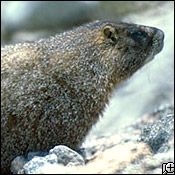Alpine marmots have distinctive calls. One long whistle warns of an aerial threat such as an eagle, while a series of whistles may warn of an approaching fox.
Like other marmots, they are social creatures found in groups of ten to fifteen.
Advertisement
They are herbivorous and hibernate in underground chambers, taking advantage of each other's body heat to make it through the winter. The chambers, although warmer than the ground surface, are cool, moist environments.
It was once believed that alpine marmot fat rubbed into the skin could relieve arthritis. The fat was also used as a source of food by mountain peoples and some considered it a delicacy.
The spread of agriculture has resulted in this marmot's decline.
Advertisement
